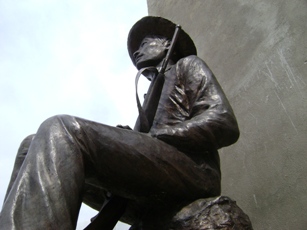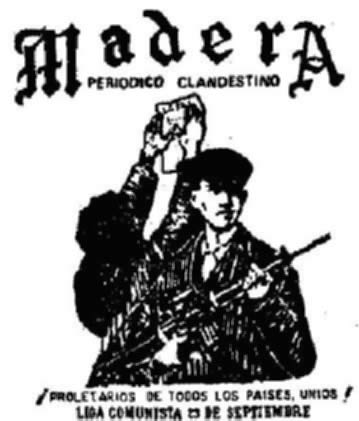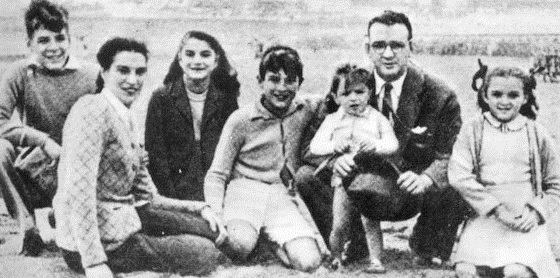|
Lucio Cabañas
Lucio Cabañas Barrientos (, 12 December 1938 – 2 December 1974) was a Mexican schoolteacher who became a revolutionary, albeit not a Marxist one. Cabañas regarded Emiliano Zapata as his role model and he never abandoned his Christian faith, as can be seen in Gerardo Tort's film documentary on him. Early life Lucio was born on December 12, 1938 into a peasant household. His paternal grandfather had been a Zapatista and his uncle Pablo, had participated in the Vidales brothers' guerilla in the 1920s. He completed his basic education in the town of El Cayaco. Later in February 1956, he entered the Ayotzinapa Normal. Teacher He was born in El Porvenir, of Atoyac de Álvarez, in the state of Guerrero. He became politically active when he studied at the Ayotzinapa Rural Teachers' College and was a leader of the local student union. In 1962 he was elected to the post of General Secretary of the Federation of Socialistic Peasant Students of Mexico. When he began work as a teach ... [...More Info...] [...Related Items...] OR: [Wikipedia] [Google] [Baidu] |
Lucio Cabañas
Lucio Cabañas Barrientos (, 12 December 1938 – 2 December 1974) was a Mexican schoolteacher who became a revolutionary, albeit not a Marxist one. Cabañas regarded Emiliano Zapata as his role model and he never abandoned his Christian faith, as can be seen in Gerardo Tort's film documentary on him. Early life Lucio was born on December 12, 1938 into a peasant household. His paternal grandfather had been a Zapatista and his uncle Pablo, had participated in the Vidales brothers' guerilla in the 1920s. He completed his basic education in the town of El Cayaco. Later in February 1956, he entered the Ayotzinapa Normal. Teacher He was born in El Porvenir, of Atoyac de Álvarez, in the state of Guerrero. He became politically active when he studied at the Ayotzinapa Rural Teachers' College and was a leader of the local student union. In 1962 he was elected to the post of General Secretary of the Federation of Socialistic Peasant Students of Mexico. When he began work as a teach ... [...More Info...] [...Related Items...] OR: [Wikipedia] [Google] [Baidu] |
Liga Comunista 23 De Septiembre
The ''Liga Comunista 23 de Septiembre'' ( en, September 23rd Communist League), or LC23S, was a Marxist-Leninist urban guerrilla movement that emerged in Mexico in the early 1970s. The result of the merging of various armed revolutionary organizations active in Mexico prior to 1974, with the objective of creating a united front to combat the Mexican government; the name was chosen to commemorate an unsuccessful guerrilla assault on the barracks of Ciudad Madera in the northern state of Chihuahua led by former schoolteacher Arturo Gámiz and the People's Guerrilla Group on September 23, 1965. The LC23S' militancy was made up mainly of young disenfranchised university students who saw any opportunity of a peaceful political transformation die in the aftermath of the 1968 student movement and then to be buried in the violent crackdown of 1971. Its long term objective was the “elimination of the capitalist system and bourgeois democracy, which would be replaced by a socialist rep ... [...More Info...] [...Related Items...] OR: [Wikipedia] [Google] [Baidu] |
Popular Revolutionary Army
The Popular Revolutionary Army or Ejercito Popular Revolucionario is a leftist guerrilla movement in Mexico. Though it operates mainly in the state of Guerrero, it has conducted operations in other southern-Mexico states, including Oaxaca, Chiapas, Guanajuato, Tlaxcala and Veracruz. The EPR announced its existence on June 28, 1996 at the commemoration of the Aguas Blancas massacre one year earlier. Dozens of rebels, carrying AK-47 and AR-15 rifles, declared war against the Mexican government and read aloud the "Aguas Blancas Manifesto", as well as firing 17 shots into the air to pay respect to the 17 who died in the massacre. Political ideology The Popular Revolutionary Army advocates socialist peasant revolution. Subcomandante Marcos has distanced the EZLN from the EPR in his communiqués, largely because of the EPR activities in the state of Chiapas in the midst of peace talks in 1996 and 1997. The EPR though still asserts its support of the Zapatistas. The Popular Revolut ... [...More Info...] [...Related Items...] OR: [Wikipedia] [Google] [Baidu] |
Carlos Montemayor
Carlos Montemayor (June 13, 1947 in Parral, Chihuahua – February 28, 2010 in Mexico City) was a Mexican novelist, poet, essayist, literary critic, tenor, political analyst, and promoter of contemporary literature written in indigenous languages. He was a Member of the Mexican Academy of the Language The Academia Mexicana de la Lengua (variously translated as the Mexican Academy of Language, the Mexican Academy of the Language, the Mexican Academy of Letters, or glossed as the Mexican Academy of the Spanish Language; acronym AML) is the corr .... Montemayor died of stomach cancer on February 28, 2010. Awards and honors *1990 José Fuentes Mares National Prize for Literature Works Novel *''Mal de piedra'' (''Blood relations'', 1980) *''Minas del retorno'' (''Gambusino'', 1982) *''Guerra en el paraíso'' (1997) *''Los informes secretos'' (1999) *''Las armas del alba'' (2003) *''La fuga'' (2007) Narrative *''Las llaves de Urgell'' (1971) *''El alba y otros cuentos'' (1986 ... [...More Info...] [...Related Items...] OR: [Wikipedia] [Google] [Baidu] |
Vladimir Lenin
Vladimir Ilyich Ulyanov. ( 1870 – 21 January 1924), better known as Vladimir Lenin,. was a Russian revolutionary, politician, and political theorist. He served as the first and founding head of government of Soviet Russia from 1917 to 1924 and of the Soviet Union from 1922 to 1924. Under his administration, Russia, and later the Soviet Union, became a one-party socialist state governed by the Communist Party. Ideologically a Marxist, his developments to the ideology are called Leninism. Born to an upper-middle-class family in Simbirsk, Lenin embraced revolutionary socialist politics following his brother's 1887 execution. Expelled from Kazan Imperial University for participating in protests against the Russian Empire's Tsarist government, he devoted the following years to a law degree. He moved to Saint Petersburg in 1893 and became a senior Marxist activist. In 1897, he was arrested for sedition and exiled to Shushenskoye in Siberia for three years, where he married ... [...More Info...] [...Related Items...] OR: [Wikipedia] [Google] [Baidu] |
Oaxaca
Oaxaca ( , also , , from nci, Huāxyacac ), officially the Free and Sovereign State of Oaxaca ( es, Estado Libre y Soberano de Oaxaca), is one of the 32 states that compose the political divisions of Mexico, Federative Entities of Mexico. It is divided into municipalities of Oaxaca, 570 municipalities, of which 418 (almost three quarters) are governed by the system of (customs and traditions) with recognized local forms of self-governance. Its capital city is Oaxaca de Juárez. Oaxaca is in southwestern Mexico. It is bordered by the states of Guerrero to the west, Puebla to the northwest, Veracruz to the north, and Chiapas to the east. To the south, Oaxaca has a significant coastline on the Pacific Ocean. The state is best known for #Indigenous peoples, its indigenous peoples and cultures. The most numerous and best known are the Zapotec peoples, Zapotecs and the Mixtecs, but there are sixteen that are officially recognized. These cultures have survived better than most others ... [...More Info...] [...Related Items...] OR: [Wikipedia] [Google] [Baidu] |
2006 Oaxaca Protests
The Mexican state of Oaxaca was embroiled in a conflict that lasted more than seven months and resulted in at least seventeen deaths and the occupation of the capital city of Oaxaca by the Popular Assembly of the Peoples of Oaxaca (APPO). The conflict emerged in May 2006 with the police responding to a strike involving the local teachers' trade union by opening fire on non-violent protests. It then grew into a broad-based movement pitting the Popular Assembly of the Peoples of Oaxaca (APPO) against the state's governor, Ulises Ruiz Ortiz. Protesters demanded the removal or resignation of Ortiz, whom they accused of political corruption and acts of repression. Multiple reports, including from international human rights monitors, accused the Mexican government of using death squads, summary executions, and even violating Geneva Conventions standards that prohibit attacking and shooting at unarmed medics attending to the wounded. One human rights observer claimed over twenty-seven w ... [...More Info...] [...Related Items...] OR: [Wikipedia] [Google] [Baidu] |
Subcomandante Marcos
Rafael Sebastián Guillén Vicente (born 19 June 1957) is a Mexican insurgent, the former military leader and spokesman for the Zapatista Army of National Liberation (EZLN) in the ongoing Chiapas conflict,Pasztor, S. B. (2004). Marcos, Subcomandante. In D. Coerver, S. Pasztor & R. Buffington, Mexico: An encyclopedia of contemporary culture and history. Santa Barbara, CA: ABC-CLIO and an anti-capitalist and anti- neoliberal globalization icon. Widely known by his initial '' nom de guerre'' Subcomandante Insurgente Marcos (frequently shortened to simply Subcomandante Marcos), he has subsequently employed several other pseudonyms: he called himself Delegate Zero during the Other Campaign (2006–2007), and since May 2014 has gone by the name Subcomandante Insurgente Galeano (again, frequently with the "Insurgente" omitted), which he adopted in honor of his fallen comrade "Teacher Galeano". Marcos bears the title and rank of Subcomandante (or "Subcommander" in English), as opposed to ... [...More Info...] [...Related Items...] OR: [Wikipedia] [Google] [Baidu] |
Che Guevara
Ernesto Che Guevara (; 14 June 1928The date of birth recorded on /upload.wikimedia.org/wikipedia/commons/7/78/Ernesto_Guevara_Acta_de_Nacimiento.jpg his birth certificatewas 14 June 1928, although one tertiary source, (Julia Constenla, quoted by Jon Lee Anderson), asserts that he was actually born on 14 May of that year. Constenla alleges that she was told by Che's mother, Celia de la Serna, that she was already pregnant when she and Ernesto Guevara Lynch were married and that the date on the birth certificate of their son was forged to make it appear that he was born a month later than the actual date to avoid scandal. ( Anderson 1997, pp. 3, 769.) – 9 October 1967) was an Argentine Marxist revolutionary. A major figure of the Cuban Revolution, his stylized visage has become a ubiquitous countercultural symbol of rebellion and global insignia in popular culture. As a young medical student, Guevara traveled throughout South America and was radicalized by the poverty, hunger, ... [...More Info...] [...Related Items...] OR: [Wikipedia] [Google] [Baidu] |
Pancho Villa
Francisco "Pancho" Villa (,"Villa" ''Collins English Dictionary''. ; ; born José Doroteo Arango Arámbula, 5 June 1878 – 20 July 1923) was a general in the Mexican Revolution. He was a key figure in the revolutionary movement that forced out President Porfirio Díaz and brought Francisco I. Madero to power in 1911. When Madero was ousted by a coup led by General Victoriano Huerta in February 1913, he led anti-Huerta forces in the Constitutionalist Army 1913–14. The commander of the coalition was civilian governor of Coahuila Venustiano Carranza. After the defeat and exile of Huerta in July 1914, Villa broke with Carranza. Villa dominated the Convention of Aguascalientes, meeting of revolutionary generals that excluded Carranza and helped create a coalition government. Emiliano Zapata and Villa ... [...More Info...] [...Related Items...] OR: [Wikipedia] [Google] [Baidu] |



.jpg)



